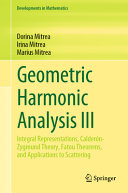

Most ebook files are in PDF format, so you can easily read them using various software such as Foxit Reader or directly on the Google Chrome browser.
Some ebook files are released by publishers in other formats such as .awz, .mobi, .epub, .fb2, etc. You may need to install specific software to read these formats on mobile/PC, such as Calibre.
Please read the tutorial at this link: https://ebookbell.com/faq
We offer FREE conversion to the popular formats you request; however, this may take some time. Therefore, right after payment, please email us, and we will try to provide the service as quickly as possible.
For some exceptional file formats or broken links (if any), please refrain from opening any disputes. Instead, email us first, and we will try to assist within a maximum of 6 hours.
EbookBell Team

5.0
110 reviewsChapter Headings: • 1. Integral Representations and Integral Identities • 2. Calderón-Zygmund Theory on Uniformly Rectifiable Sets • 3. Quantitative Fatou-Type Theorems in Arbitrary UR Domains • 4. Green Functions and Uniqueness for Boundary Problems for Second-Order Systems • 5. Green Functions and Poisson Kernels for the Laplacian • 6. Scattering by Rough Obstacles
This monograph presents a comprehensive, self-contained, and novel approach to the Divergence Theorem through five progressive volumes. Its ultimate aim is to develop tools in Real and Harmonic Analysis, of geometric measure theoretic flavor, capable of treating a broad spectrum of boundary value problems formulated in rather general geometric and analytic settings. The text is intended for researchers, graduate students, and industry professionals interested in applications of harmonic analysis and geometric measure theory to complex analysis, scattering, and partial differential equations.
Volume III is concerned with integral representation formulas for nullsolutions of elliptic PDEs, Calderón-Zygmund theory for singular integral operators, Fatou type theorems for systems of elliptic PDEs, and applications to acoustic and electromagnetic scattering. Overall, this amounts to a powerful and nuanced theory developed on uniformly rectifiable sets, which builds on the work of many predecessors.